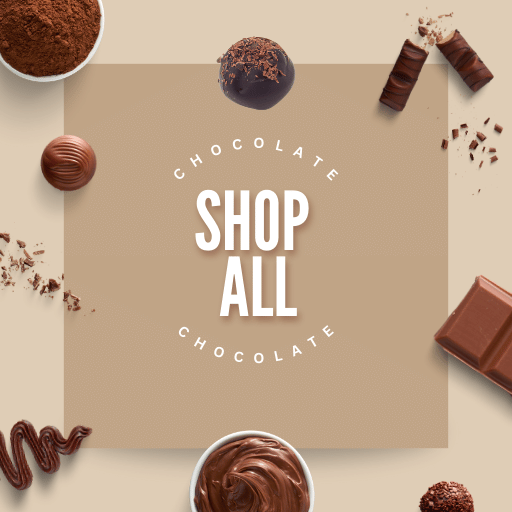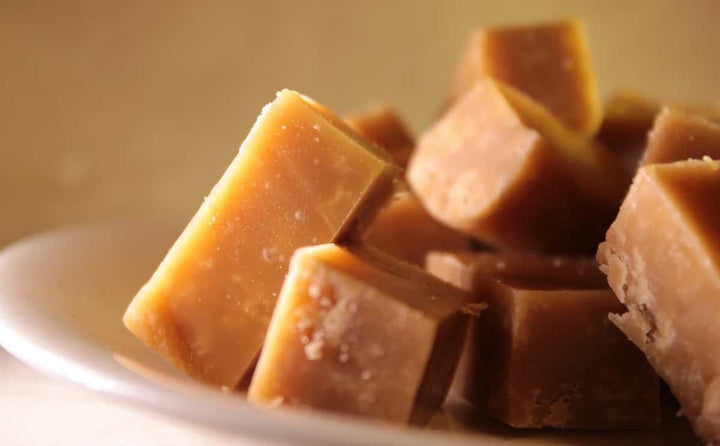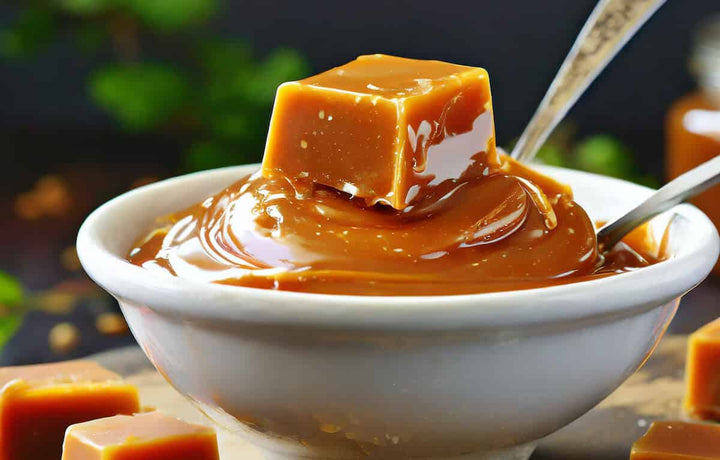Fudge, a classic confectionery delight, holds a special place in the hearts of sweet lovers across the UK and beyond.
This delectable treat, known for its smooth, creamy texture and rich, sweet flavour, has a fascinating history and an array of variations that make it a versatile favourite.
Fudge offers something for every palate, whether it's the traditional vanilla, the ever-popular chocolate, or more adventurous flavours like salted caramel or clotted cream.
Join us on this sweet journey as we uncover the secrets behind making exquisite fudge and discover how this beloved treat has been reinvented and enjoyed through the ages.
What is Fudge?
Fudge is a rich, sweet confectionery that has been cherished in British culinary tradition for many years.
Characterised by its smooth, creamy texture and decadent flavour, fudge is typically made from a mixture of sugar, butter, and milk or cream.
The ingredients are heated to the soft-ball stage, around 235-245°F (113-118°C), and then beaten while cooling, which gives fudge its characteristic smooth and dense texture.
The most traditional form of fudge is plain or vanilla, but it can be found in many flavours.
Chocolate fudge is particularly popular, as are varieties incorporating nuts, fruits, and other flavourings such as caramel, peanut butter, or mint.
Some versions also include marshmallows or condensed milk for added richness and texture.
Fudge is often associated with seaside towns in the UK, where it is a popular treat and souvenir.
It's also a festive favourite, especially during Christmas, and is commonly made at home for special occasions.
The beauty of fudge lies in its simplicity and the endless possibilities for variation, making it a beloved treat for both connoisseurs and casual, sweet-toothed enthusiasts alike.

What is Fudge Made Of?
Fudge, a much-loved sweet treat in the UK, is traditionally made from a simple yet delightful combination of ingredients.
The basic components of classic fudge include:
-
Sugar: This is the primary ingredient and forms the base of fudge. Granulated sugar is commonly used, providing a sweet flavour and adding texture.
-
Butter: Butter adds richness and creaminess to fudge, enhancing its texture and flavour. It also helps achieve the smooth, melt-in-the-mouth consistency that fudge is famous for.
-
Milk or Cream: Milk or cream is essential for creating the smooth texture of fudge. It helps dissolve the sugar and blends with the butter to give fudge its characteristic creamy consistency. Some recipes use condensed milk for a richer taste.
These ingredients are combined and heated to the soft-ball stage, around 235-245°F (113-118°C).
This precise heating is crucial as it allows the sugar to reach the right concentration and consistency.
Once heated, the mixture is cooled and beaten until it's thick and smooth, resulting in fudge's dense and creamy texture.
Many variations of fudge include additional ingredients like:
-
Chocolate: For making chocolate fudge, which adds a rich, cocoa flavour.
-
Vanilla Extract: For added flavour, especially in plain or vanilla fudge.
-
Nuts: Such as walnuts or pecans, for added crunch and flavour.
-
Dried Fruits: Like raisins or cherries for a fruity twist.
-
Other flavourings: Including peanut butter, caramel, or mint for diverse flavour profiles.
How is Fudge Made?
Fudge is made by melting sugar, milk cream, and butter together, then heating the mixture to the softball stage while stirring continuously.
After reaching the desired temperature, it's removed from heat, flavourings are added, and it's beaten as it cools.
This beating process forms small sugar crystals, giving fudge its smooth texture.
Finally, the mixture is poured into a tray to set, then cut into squares for serving. The process relies heavily on precise temperature control and timing to achieve the perfect consistency.
Is Fudge Chocolate?
Fudge and chocolate are different confections, although they can appear similarly.
Fudge is a creamy sweet made from sugar, butter, and milk or cream, often vanilla-flavoured but available in various flavours, including chocolate.
Chocolate itself is derived from cocoa beans and includes cocoa butter, sugar, and sometimes milk, offering a distinct taste and texture that varies from smooth and creamy in milk chocolates to intense in dark chocolates.
Therefore, while fudge can be chocolate-flavoured, it is a separate confection, and its chocolate variety is just one of many. Chocolate is a versatile ingredient used in many sweets, including fudge.

What is Chocolate Fudge?
Chocolate fudge is a variation of the classic confectionery treat, fudge, infused with chocolate's rich and indulgent flavour.
It combines the creamy, smooth texture of traditional fudge with the deep, cocoa-based taste of chocolate, resulting in a luxurious and satisfying sweet.
How to Make Fudge at Home
Making fudge at home is a delightful and rewarding process that allows you to create a delicious treat with a few simple ingredients.
Here's a basic recipe for making traditional vanilla fudge, which you can customise with your choice of flavours or additions:
Ingredients:
- 450g granulated sugar
- 100g butter
- 150ml milk
- 1 tsp vanilla extract (optional, for flavour)
Equipment:
- Heavy-bottomed saucepan
- Sugar thermometer (optional but helpful)
- Square baking tin (about 20cm)
- Baking parchment
Method:
-
Prepare the Baking Tin: Line the baking tin with parchment, ensuring it covers the base and sides. This will make it easier to remove the fudge once it's set.
-
Combine the Ingredients: In the heavy-bottomed saucepan, combine the sugar, butter, and milk. The heavy base of the pan will help prevent the mixture from burning.
-
Heat the Mixture: Place the saucepan over low heat and stir until the sugar has completely dissolved and the butter has melted. It's important to keep the heat low and stir constantly to avoid burning the mixture.
-
Boil the Mixture: Once the sugar has dissolved, turn up the heat and bring the mixture to a boil. Continue boiling until the mixture reaches the softball stage (around 116°C/240°F). You can use a sugar thermometer to check this. If you don't have a thermometer, you can test it by dropping a small amount of the mixture into cold water. It should form a soft ball that flattens when removed from the water.
-
Cool and Beat: Remove the saucepan from the heat and let the mixture cool for a few minutes. Then, add the vanilla extract (if using) and beat it vigorously until it thickens and becomes grainy. This is an important step as it gives fudge its characteristic texture.
-
Pour and Set: Pour the beaten fudge mixture into the prepared tin and smooth the top with a spatula. Leave it to cool at room temperature until it sets. This could take a few hours.
-
Cut the Fudge: Once the fudge has set and is firm to the touch, remove it from the tin and peel off the baking parchment. Use a sharp knife to cut the fudge into small squares or rectangles.
Remember, making fudge requires patience, particularly when stirring the mixture and waiting for it to reach the correct temperature.
What Does Fudge Taste Like?
Traditional vanilla fudge has a smooth, buttery taste with a hint of caramel derived from cooking sugar, butter, and milk or cream.
The vanilla adds a delicate, aromatic flavour, enhancing the overall taste experience.
The texture is dense yet soft, melting delightfully in the mouth, a key part of its appeal.
On the other hand, chocolate fudge incorporates the indulgent and rich taste of cocoa or chocolate, adding depth and complexity to the sweetness.
It's like a cross between a chocolate bar and the traditional creamy fudge, offering a more intense flavour for chocolate lovers.
There are also many other variations of fudge, each with its unique taste.
Adding nuts, fruits, or other flavourings can introduce different textures and tastes, making each type of fudge a unique treat.
Where Can You Buy Tasty Fudge?
You can find exceptionally tasty fudge at Whitakers Chocolates, renowned for our hand-made traditional all-butter fudge.
We offer a delightful range, including fudge made with clotted cream, ensuring a rich and creamy experience.
Click here to see our delicious range of fudge...
Some Notes From an Expert Chocolatier
As an expert chocolatier, it's a source of immense pride for me to continue the tradition of making fudge using the famous original recipe passed down from our Great Aunt Ida.
This time-honoured recipe, steeped in family history, has been a cornerstone of our craft for generations.
Using classic techniques and simple, high-quality ingredients, we've maintained the authenticity and rich flavours that have been cherished over the years.
There's something truly special about preserving a family recipe, especially one as beloved as Aunt Ida's fudge.
It connects us to our heritage and keeps the legacy alive through each batch of fudge we craft.
This dedication to tradition is not just about following a recipe; it's about capturing a piece of history and sharing it with every person who tastes our fudge.
These connections to the past, combined with the joy our fudge brings to the present, make our work so fulfilling.
Final Notes On Fudge
Fudge is more than just a confectionery item; it's a symbol of culinary heritage and a testament to the simplicity of traditional sweet-making.
Its rich, creamy texture and deep, indulgent sweetness have made it a beloved treat in the UK and worldwide.
From the classic vanilla to the luxurious chocolate and the unique flavours that have emerged over time, fudge continues to be a versatile and cherished sweet.
Fudge, in all its varieties, remains a timeless treat, combining the nostalgia of the past with the pleasures of the present.











